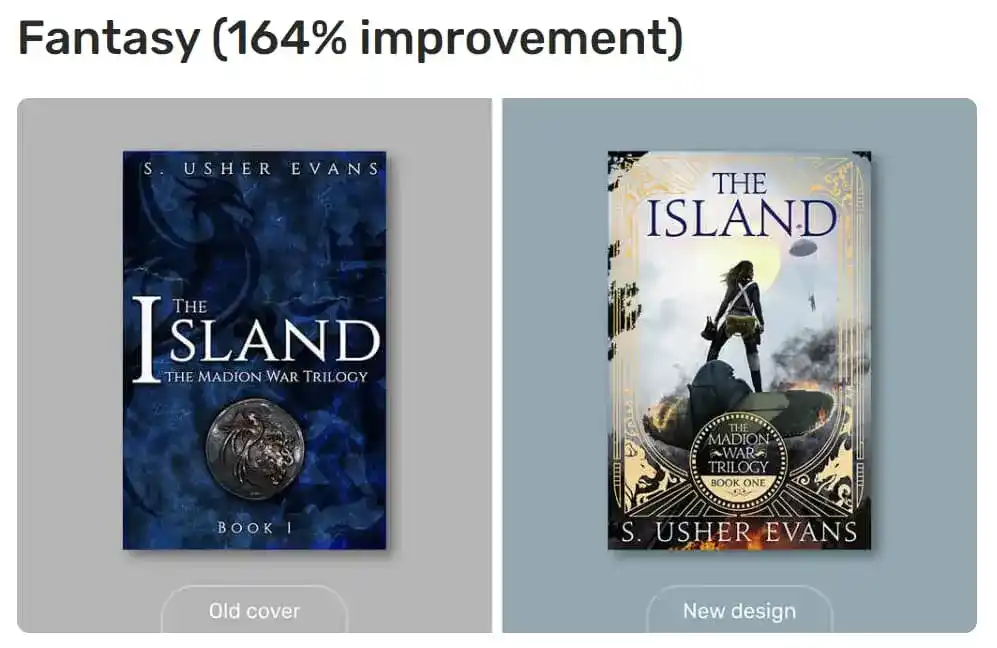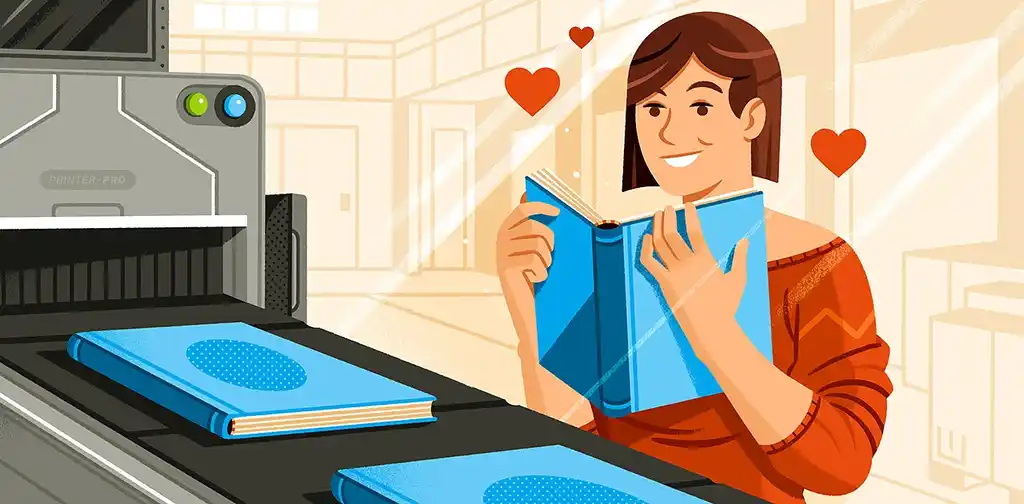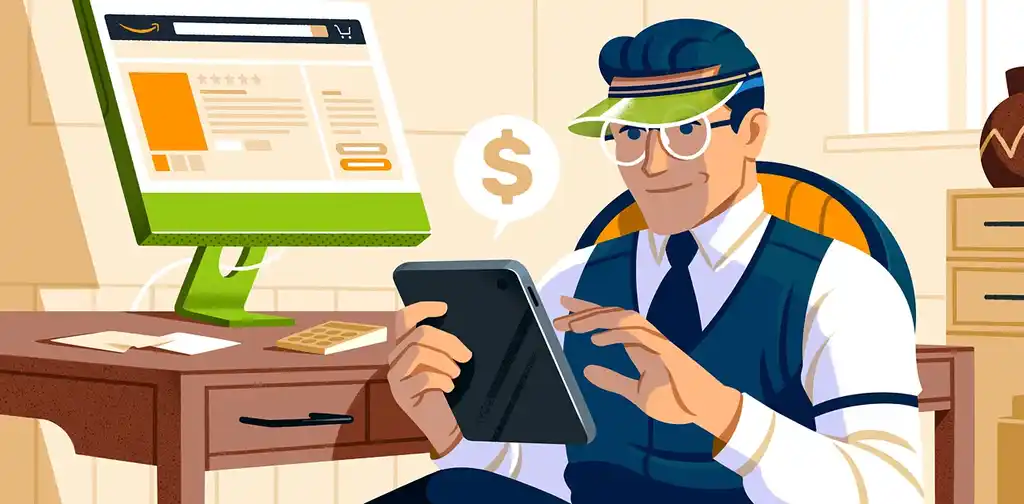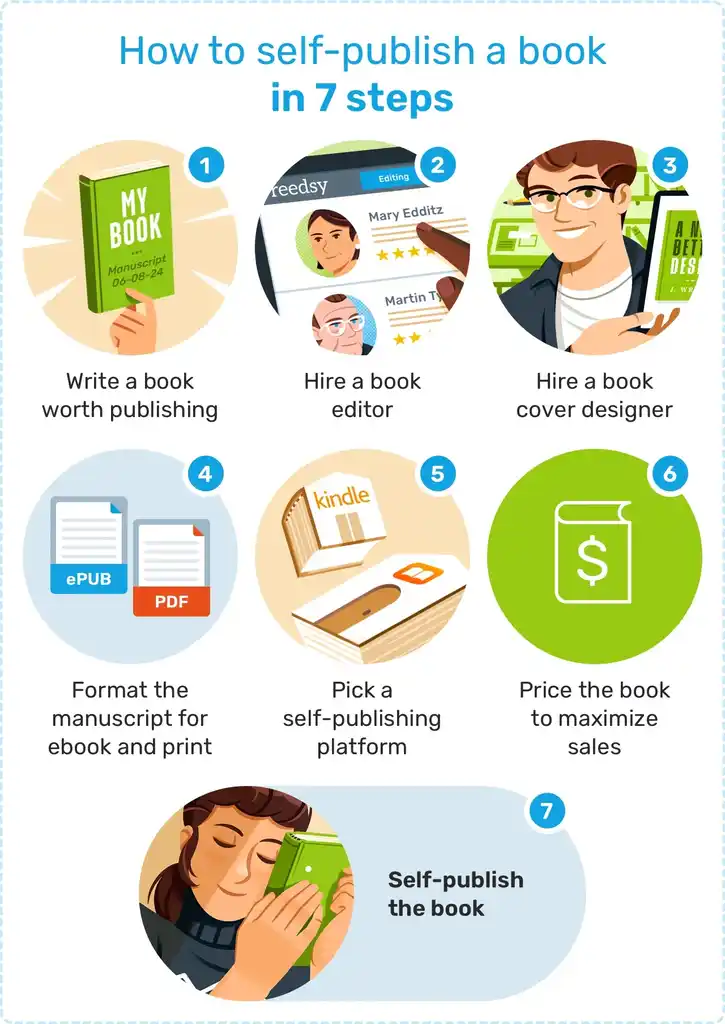Guides • Understanding Publishing
Last updated on Feb 15, 2024
How to Self-Publish a Book in 2024 [+ Checklist]
Are you looking to self-publish and join the thousands of authors every year who enjoy complete creative control and a greater portion of royalties? If so, we're here to show you how to get your book out into the world on your terms with the help of a seven-step process and a host of extra resources.
How to self-publish a book in 7 steps:
1. Write a book with market potential
If you want to know how to self-publish a book, it’s likely that you’ve just completed your manuscript or you’re actively working on it.
If your masterpiece is finished, congratulations! That’s an impressive milestone in and of itself. This article will guide you through the next steps to publish your work.
Meanwhile, for those still in the writing phase, we recommend checking out our post on how to write a book, which will help you validate your book idea and navigate the entire writing process.
While the appeal of self-publishing lies in its limitless creative freedom, this post will assume that you aim to release your book for market success. This implies that in addition to being unique, your manuscript aligns with its book genre and resonates with an existing audience of readers.
Having done your market research and drafted your manuscript, you’re now hoping to take the literary world by storm. But before we get ahead of ourselves, you need to refine and edit your manuscript to ensure it reaches its highest potential.
2. Edit it to near perfection
Seasoned authors will know that editing isn’t just a chore that needs to be tolerated, but also a creatively exciting part of the writing journey. It’s where the raw material of your first draft gets shaped and honed into a book that readers will want to cherish. The way we see it, this process can be broken down into a few stages.
Self-edit your first few drafts
Before anyone else sets eyes on your manuscript, try to write the best book you possibly can. For novelists, that means working through a few drafts to really nail the storyline and the believability of your character's motivations. For non-fiction writers, it could mean tightening up your chapters and re-evaluating how your central message is conveyed.
Share your draft with beta readers
Having fresh eyes review your manuscript is also invaluable. Share your work with beta readers to receive constructive feedback and with sensitivity readers to get help with spotting cultural inaccuracies and biases.
Before you share anything with these first readers, you may wish to clear your work of basic grammar mistakes and typos, which you can do using free proofreading tools. You’ll be focusing on the sentence-level edits later on in the process, so there’s no need to lose sleep over dotting every “i” at this point.
🤓 Here are two free courses we offer to help you revise and self-edit your manuscript:
- Novel Revision: Practical Tips for Rewrites 一 A 10-part course that includes great lessons on working with critique partners and beta readers.
- How to Self-Edit Your Manuscript Like a Pro 一 Learn how to spot the ten most common writing mistakes.
Let a professional help you cross the finish line
Even your best self-editing efforts might not be enough. Traditionally published books undergo multiple rounds of professional editing before hitting the shelves, and you should aim for the same standard of quality. There are various types of editing to consider, with the most crucial being:
Developmental Editing: This type of editing focuses on addressing overarching issues in your manuscript, such as structure, plot, and character development, ensuring the foundation of your book is solid.
Copy Editing: The editor reviews the text line-by-line to correct grammatical errors and punctuation mistakes and resolve any voice or tone inconsistencies.
Proofreading: The final polish to catch any remaining typos or minor errors, ensuring your manuscript is flawless and print-ready.
Depending on what your book needs the most, consider bringing in the right professional. These days, finding your ideal editor is easier than ever. On the Reedsy Marketplace, you can search for (and request quotes from) professionals with specific experience in your genre.
The cost of editing will depend on the service you choose, your word count, your book’s genre, and the freelancer’s experience. For example, for a 60,000-word book, you can expect to pay between $1,000 and $2,000 for most editing services. Try out our calculator below to determine how much you’d pay for editing services.
Pricing calculator
Calculate the average cost of editing services for your genre.
Editorial Assessment
Developmental Editing
Copy Editing
Proofreading
Okay, your manuscript has been edited, polished, and proofed. Now it’s time to make sure your book looks as good on the outside as it does on the inside.

Polish your book with expert help
The best editors in the industry are on Reedsy. Come meet them.
Learn how Reedsy can help you craft a beautiful book.
3. Get a beautiful book cover
The value of a great book cover design cannot be overstated, especially in self-publishing. It’ll be your most-used book marketing asset and a cornerstone of your overall publishing success.
To prove this, we conducted an experiment to evaluate whether professionally designed covers drive more ad clicks. We did the test for seven books across a range of genres, and the results were significant, with some books experiencing over a 60% increase in conversion rates.

If you're a seasoned designer familiar with genre tropes, typography, and visual hierarchy — in addition to being capable of handling technicalities like trim sizes, spine width, and back cover design — then by all means, design your own cover.
However, if you lack this expertise but still aim for a stunning book cover, you’ll want to work with an experienced designer. Reedsy offers a broad array of professional book cover designers to help bring your vision to life. Based on our internal data, the cost of a book cover typically ranges between $500 and $800 if you’re hiring a skilled professional.
But don’t forget about the interior
While your book cover plays a crucial role in driving sales, whether that be through ads or as a thumbnail used by online retailers, don't overlook the importance of interior design, which encompasses the page layout and text formatting.
Reedsy has a free book formatting tool with a user-friendly interface that will get your book ready for publication in under an hour. You can simply import your manuscript and effortlessly format headings and paragraphs, insert images and endnotes, create a copyright page, and much more. Read our post on how to format your book with Reedsy’s free publishing app for further info.
For books requiring intricate interior designs, such as photography books or cookbooks, you might consider hiring a designer. On average, this service costs between $250 and $750.
Once you’ve taken care of your book’s outer and inner design, you just need to prepare the files to start selling and distributing it.
4. Prepare your ebook and print files
The next step is to prepare the files for printing your book. Each service has slightly different requirements for file upload, but in general, you’ll need an EPUB file for the ebook version and a PDF file for print. For the manuscript, you can get both types of files for free using Reedsy’s writing app. Once you’re happy with how you’ve formatted your book, identify the trim size you need and simply export the files!
For the cover design, if you’re working with a professional, just let them know what platform you want to use to print the book and they’ll take care of the details. If you’re making the cover on your own, read about the platform requirements for file upload and follow them carefully.
A word on audiobooks
The audio format has skyrocketed in popularity, and many self-published authors who have invested in audiobooks have reaped the benefits. If you want to take advantage of the audiobook market, check out our guide on how to make an audiobook as an indie author. You’ll also find all the important details to know about how to create and distribute your audiobook files.
Now that you’ve got the files prepared, it’s time to upload them to your retailer of choice.
5. List your book on a self-publishing platform
You’ll need to choose a self-publishing platform that offers print-on-demand (POD) and distribution to customers. POD is a type of printing service that will only print and dispatch paperback or hardcover copies after customers buy them. Most self-publishing authors choose it over traditional offset printing because it minimizes the risk of unsold inventory that comes with pre-printing thousands of copies.

The two largest POD services in the world are Kindle Direct Publishing (KDP) and IngramSpark. Both let you upload your book and list it on their platforms for free, and they also provide comparable book products at similar printing and shipping costs. They notably offer different royalty schemes and distribution deals that mainly depend on whether you wish to also distribute your book through non-Amazon retailers.
You can still investigate other POD services to see which one makes more sense for you and your book. Most of them are free, while some, like Bookbaby and Bookvault, have setup fees. For detailed comparisons, check out our post in which we tested and reviewed all the major POD book services.
Mastering Amazon’s KDP
Since many authors rely on Amazon to drive most of their sales, learning how to properly list your book on it is crucial. Read our guide to Amazon Self-Publishing for a deep dive, and consider these quick tips below:
Write a description that sells. Start with a compelling tagline to draw readers in and reveal your book's tone, genre, and some story elements (e.g., “A Village, A Murder, A Keen-eyed Sleuth.”) Or you could feature a notable mention or editorial reviews you've received (e.g., “An evocative story that will make a lasting impression on readers.” Booklife Reviews). Read our post on how to write an Amazon book description for more tips.
Pick your categories and keywords wisely. In selecting categories for your book, it's wise to choose one broad category (such as Romance) and one more specific niche (like Enemies to Lovers). Regarding choosing keywords, opt for terms not already included in your title and description so that potential readers can discover your work through varied search queries.
Get your own ISBN
At this point, you may be wondering whether you need your own ISBN number, as well as how much it costs. The quick answer is that owning your ISBN allows you to register as your book’s publisher, maintaining publishing rights across various retailers. And if you want to publish more book formats (e.g., ebook, paperback, audiobook), you need multiple barcodes. On Bowker, a single ISBN number costs $125, but you have the option to buy a bundle of 10 barcodes for $295. For more information, read our guide on how to get an ISBN number.
👀
Do you need an ISBN number?
It'll only take a minute!
If Amazon isn’t suitable for you, there are other self-publishing companies that you can leverage to distribute your book to readers around the world, like Apple Books, Kobo, and Google Play, or aggregators like Draft2Digital. You’ll have to find the one that most aligns with your values and goals before deciding on your book’s price strategy.
📚 Read The Complete Guide to Ebook Distribution: it contains everything you need to know about selling your digital book, including sections about going "exclusive" with Amazon, alternative retailers like Kobo and Barnes & Noble, and instructions on setting your book up on retailers.
6. Price the book to maximize sales
Setting your book price is a delicate balance. If you price it too high, you will profit more with every copy sold, but you may sell far fewer copies. Similarly, underpricing a book may sell more units but leave you with less money at the end of each month. So how should you price your work?
Research your market
The first prerequisite to setting your book’s price is to know your market inside out. What is considered a “normal” price for a book like yours? You can find that out by perusing the bestseller lists in your genre and looking at their prices.
Ricardo Fayet, author of How to Market Your Book, points out that for many years, traditional publishers have been voluntarily overpricing ebooks in an effort to protect their print sales.
"You can’t really trust the prices of famous, traditionally published ebooks in your genre. Instead, look for high-selling titles from independent authors in your genre, and use those as a benchmark."

Lower your price to build your fanbase
As part of your grander strategy, Ricardo also mentions that price can be a great tool to entice readers to take a chance on your book. “While you can certainly mimic the prices of the most famous indie authors in your category, it can also be a good idea to price your books a tad lower as a start, just to start building that fanbase.”
Once you have an established readership, they’ll have no problem paying more to get your future releases. And once you have multiple books in your back catalog, your pricing tactics can get more sophisticated.
For a series, adopt a staircase pricing strategy
The most successful self-published authors are usually the ones who write a series of books. One of the reasons for this is that it only requires the author to heavily market the first book in the series. If the reader likes that first book, they will be inclined to buy the next book (and perhaps even pay more for it).
With a series, Ricardo suggests starting with a free (or heavily discounted) ebook and then progressively raising the prices as readers get deeper into the series.
"For example, you could offer book one for $0.99, book two for $2.99, book three for $3.99, and the rest of the books in the series for $5.99. Once a reader is heavily invested in your series — and absolutely needs to know what happens next — pricing is not as big a factor in their purchasing decision."
To learn more about using price promotions to boost your sales and ensure your publication is priced correctly in all countries, check out Reedsy’s free course on pricing books for an international audience.
7. Self-publish and promote the book
Now that you’ve exported the finished product, uploaded your book to your retailer of choice, and selected a price, all that's left is to pull the trigger and... congratulations, you’ve published your book!
However, if you want to give your book the best chance to thrive on Amazon and other platforms, you’ll need a proper book launch. A lot hinges on a book’s first few weeks on the market 一 your title must accumulate a healthy dose of book sales and reviews right away.
Note that, while this is a post-publication step, it's important that you create an effective and timely book publicity plan weeks in advance. It takes some to plan PR activities like reviews, interviews, live readings, and podcast appearances. With that in mind, keep on reading for a few key steps to consider.
Get book reviews
One of the key elements of sales is gathering social proof 一 people who read your book and (hopefully) give it a positive review. There are several ways to get book reviews. You could ask book bloggers to review your work, send ARC copies to your friends, followers, and other potential readers, or pay $50 for a high-quality review on sites like Reedsy Discovery.
For advanced tips on how to get reviews on your Amazon’s book page before your launch day, read our post on how to promote your book.
Create an author media kit
Another important piece of the marketing puzzle is creating an author media kit. This kit should include things like your author bio, book pitch, a tip sheet (like a sample Q&A for interviews and author events), and other promotional information. You can make the kit a standalone PDF, an online folder with various resources, or a dedicated page on your author website — choose whatever method makes it easiest for you to share your content with media outlets. For more guidance, read our post on building a rocking author media kit.
Keep marketing your book
There are many other marketing strategies you can implement, from learning how to make the most of your social channels to running Amazon ads and more. We’ve collected over 70 book marketing ideas in another post in case you want to go deeper.
If marketing isn't your forte or you're short on time, consider hiring a book marketer. They specialize in optimizing your book's metadata and product pages, setting up and teaching you how to manage ad campaigns, and building your mailing list. While a comprehensive marketing strategy costs around $1,100 on average, you can drastically reduce costs by opting for specific services (e.g., only counseling on advertising).
If you’ve followed all the steps in this post, congratulations! Not only have you finally published your book you worked so hard on, but you've also given it the best chance to succeed.
There are many success stories of self-publishing authors making bank with their stories, and thanks to higher royalty rates, indie authors can potentially earn up to five times more than writers who go the traditional publishing route. If you're interested in learning more, read our post on what authors can expect to earn for a closer look at the numbers of self-publishing.
In the next part of this guide, we'll show you the benefits (and potential drawbacks) of self-publishing. Be sure to read on!


